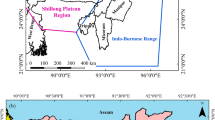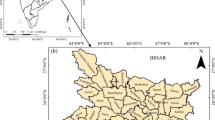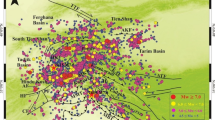Abstract
The Northwest Himalaya and its adjoining regions are one of the most seismically vulnerable regions in the Indian subcontinent which have experienced two great earthquakes [1902 Caucasus of magnitude M S 8.6 and 1905 Kangra, India of M S 8.6 (M W 7.8)] and several large damaging earthquakes in the previous century. In this study, time-dependent seismicity analysis is carried out in five main seismogenic zones in the Northwest Himalaya and its adjoining regions by considering earthquake inter-arrival times using a homogeneous and complete earthquake catalogue for the period 1900–2010 prepared by Yadav et al. (Pure Appl Geophys 169:1619–1639, 2012a). For this purpose, we consider three statistical models, namely Poisson (time independent), Lognormal and Weibull (time dependent). Fitness of inter-arrival time data is investigated using Kolmogorov–Smirnov (K–S) test for Lognormal and Weibull models, while Chi-square test is applied for the Poisson model. It is observed that the Lognormal model fits remarkably well to the observed inter-arrival time data, while the Weibull model exhibits moderate fitting. The parameters A and B of the time-dependent seismicity equation \(\ln {\text{IAT}} = A + BM \pm C\) (where ln IAT is the log of inter-arrival times of earthquakes exceeding magnitude M and C is the standard deviation), developed by Musson et al. (Bull Seismol Soc Am 92:1783–1794, 2002) are evaluated in each of the five main seismogenic zones considered in the region. The mean of the inter-arrival times for the Lognormal distribution is found to be linearly related to the lower-bound magnitude (M min). Values of the slope (B) of the mean vary from 2.34 to 2.57, while the parameter A ranges from −9.06 to −7.01 in the examined seismogenic zones with standard deviation ranging from 0.21 to 0.38. It is observed that the Hindukush–Pamir Himalaya and Himalayan Frontal Thrust exhibit higher seismic hazard (i.e., high seismic activity and low recurrence periods), while the Sulaiman–Kirthar ranges show the lowest. The variation in estimated seismicity parameters from one zone to another reveals high crustal heterogeneity and seismotectonic complexity in the study region.








Similar content being viewed by others
References
Anagnos T, Kiremidjian AS (1988) A review of earthquake occurrence models for seismic hazard analysis. J Probab Eng Mech 3:3–11
Arora BR, Gahalaut VK, Kumar N (2012) Structural control on along-strike variation in the seismicity of the Northwest Himalaya. J Asian Earth Sci 57:15–24
Bapat A, Kulkarni RC, Guha SK (1983) Catalogue of earthquakes in India and neighborhood from historical period up to 1979. I.S.E.T (Publ), pp 1–211
Bufe CG, Harsh PW, Buford RO (1977) Steady-state seismic slip—a precise recurrence model. Geophys Res Lett 4:91–94
Burtman V, Molnar P (1993) Geological and geophysical evidence of deep subduction of continental crust beneath the Pamir. Geol Soc Am Spec Pap 281:1–76
Chandra U (1978) Seismicity, earthquake mechanisms and tectonics along the Himalayan mountain range and vicinity. Phys Earth Planet Inter 16:109–131
Chatelain JL, Roeker SW, Hatzfeld D, Molnar P (1980) Micro-earthquake seismicity and fault plane solutions in the Hindukush region and their tectonic implications. J Geophys Res 85:1365–1387
Chingtham P, Chopra S, Baskoutas I, Bansal BK (2013) An assessment of seismicity parameters in northwest Himalaya and adjoining regions. Nat Hazards 71(3):1599–1616
Cramer CH, Petersen MD, Cao T, Toppozada TR, Reichle M (2000) A time-dependent probabilistic seismic-hazard model for California. Bull Seismol Soc Am 90(1):1–21
Davis PM, Jackson DD, Kagan YY (1989) The longer it has been since the last earthquake, the longer the expected time till the next? Bull Seismol Soc Am 79:1439–1456
Erdik M, Demircioglu M, Sesetyan K, Durukal E, Siyahi B (2004) Earthquake hazard in Marmara region, Turkey. Soil Dyn Earthq Eng 24:605–631
Fan G, Ni JF, Wallace TC (1994) Active tectonics of the Pamir and the Karakoram. J Geophys Res 99:7131–7160
Frankel AD, Petersen MD, Muller CS, Haller KM, Wheeler RL, Leyendecker EV, Wesson RL, Harmsen SC, Cramer CH, Perkins DM, Rukstales KS (2002) Documentation for the 2002 update of the national seismic hazard maps. US Geol Surv Open File Rept 2–420
Gansser A (1964) Geology of the Himalayas. Inter-Science, London
Gardner JK, Knopoff L (1974) Is the sequence of earthquakes in southern California, with aftershocks removed, Poissonian? Bull Seismol Soc Am 64:1363–1367
Goes SDB, Ward SN (1994) Synthetic seismicity for the San Andreas fault. Ann Geof 37:1495–1513
Gutenberg B, Richter CF (1954) Seismicity of the earth and associated phenomena. Princeton University Press, New Jersey, p 310
Kagan YY, Jackson DD (1991) Long-term earthquake clustering. Geophys J Int 104:117–133
Kagan Y, Knopoff L (1976) Statistical search for non-random features of the seismicity of strong earthquakes. Phys Earth Planet Inter 12:291–318
Kijko A (2004) Estimation of the maximum earthquake magnitude M max. Pure appl Geophys 161:1–27
Kijko A, Sellevoll MA (1989) Estimation of seismic hazard parameters from incomplete data files part I: utilization of extreme and complete catalogues with different threshold magnitudes. Bull Seismol Soc Am 79:645–654
Kijko A, Sellevoll MA (1992) Estimation of earthquake hazard parameters from incomplete data files part II: incorporation of magnitude heterogeneity. Bull Seismol Soc Am 82(1):120–134
Knopoff L, Levshina T, Keilis-Borok VI, Mattoni C (1996) Increased long-range intermediate-magnitude earthquake activity prior to strong earthquakes in California. J Geophys Res 101:5779–5796
Koulakov I, Sobolev S (2006) A tomographic image of Indian lithosphere break-off beneath the Pamir–Hindukush region. Geophys J Int 164:425–440
Kumamoto T (1999) Seismic hazard maps of Japan and computational differences in models and parameters. Geograph Rev Jpn Ser B 72(2):135–161
Meltzer A, Sarker G, Beaudoin B, Seeber L, Armbruster J (2001) Seismic characterization of an active metamorphic massif, Nanga Parbat, Pakistan Himalaya. Geology 29:651–654
Mulargia F, Tinti S (1985) Seismic sample areas defined from incomplete catalogs: an application to the Italian territory. Phys Earth Planet Inter 40(4):273–300
Musson RMW, Tsapanos T, Nakas CT (2002) A power-law function for earthquake interarrival time and magnitude. Bull Seismol Soc Am 92:1783–1794
Oldham T (1883) A catalogue of Indian earthquakes from the earliest time to the end of A.D. 1869. Mem Geol Surv India 19(3):53
Pace B, Perruzza L, Lavecchia G, Bancio P (2006) Layered seismogenic source model and probabilistic seismic-hazard analyses in central Italy. Bull Seismol mol Soc Am 96:107–132
Papadimitriou EE, Papazachos BC (1994) Time dependent seismicity in the Indonesian region. J Geophys Res 99:15387–15398
Papaioannou C, Papazachos C (2000) Time-independent and time-dependent seismic hazard in Greece based on seismogenic sources. Bull Seismol Soc Am 90:22–33
Papazachos BC (1989) A time predictable model for earthquake generation in Greece. Bull Seismol Soc Am 79:77–84
Papazachos BC (1992) A time and magnitude predictable model for generation of shallow earthquakes in the Aegean area. Pure appl Geophys 138:287–308
Papazachos BC, Papaioannou ChA (1993) Long term earthquake prediction in Aegean area based on a time and magnitude predictable model. Pure appl Geophys 140:593–612
Papazachos BC, Papadimitriou EE, Karakaisis GF, Tsapanos TM (1994) An application of the time- and magnitude-predictable model for the long-term earthquake prediction of strong shallow earthquakes in the Japan area. Bull Seismol Soc Am 84:426–437
Papazachos BC, Karakaisis GF, Papadimitriou EE, Papaioannou ChA (1997) The regional time and magnitude-predictable model and its application to the Alpine–Himalayan belt. Tectonophysics 271:295–323
Parvez IA, Ram A (1997) Probabilistic assessment of earthquake hazards in the north-east Indian peninsula and Hindukush regions. Pure appl Geophys 149:731–746
Parvez IA, Ram A (1999) Probabilistic assessment of earthquake hazards in the Indian subcontinent. Pure appl Geophys 154:23–40
Peruzza L, Pace B (2002) Sensitivity analysis for seismic source characteristics to probabilistic seismic hazard assessment in central Appennines (Abruzzo area). Boll di Geofisica Teorica ed Applicata 43:79–100
Petersen MD, Cao T, Campbell KW, Frankel AD (2007) Time-independent and time-dependent seismic hazard assessment for the state of California: Uniform California Earthquake rupture forecast model 10. Seismol Res Lett 78(1):99–109
Petersen MD, Frankel AD, Harmsen SC, Mueller CS, Haller KM, Wheeler RL, Wesson RL, Zeng Y, Boyd OS, Perkins DM, Luco N, Field EH, Wills CJ, Ruksatles KS (2008) Documentation for the 2008 update of the United States national seismic hazard maps. US Geol Surv Open File Rept 2008–1128:60
Quittmeyer RC, Jacob KH (1979) Historical and modern seismicity of Pakistan, Afghanistan, northern India, and southern Iran. Bull Seismol Soc Am 69:773–823
Reid HF (1911) The elastic-rebound theory of earthquakes. Univ Calif Pub Bull Dept Geol 6:413–444
Seeber L, Armbruster JG (1981) Great detachment earthquakes along the Himalayan arc and long forecasting: In: Richards DW, Simpson PG (eds) Earthquake prediction—an international review, Maurice Ewing Series. American Geophysical Union, vol 4, pp 259–277
Shanker D, Yadav RBS, Singh HN (2007) On the seismic risk in the Hindukush–Pamir Himalaya and their vicinity. Curr Sci 92:1625–1630
Shimazaki K, Nakata T (1980) Time predictable recurrence of large earthquakes. Geophys Res Lett 7:279–282
Shimazaki K, Kawase K, Satake K, Suzuki Y, Ogata Y, Imoto M, Kumamoto T (1999) Renewal recurrence models for large earthquakes in Japan. IUGG99 Abstracts 2:B182
Sornette D, Knopoff L (1997) The paradox of the expected time until the next earthquake. Bull Seismol Soc Am 87:789–798
Sykes LR, Quittmeyer RC (1981) Repeat times of great earthquakes along simple plate boundaries. In: Earthquake prediction, an international review, Maurice Ewing Series. American Geophysical Union, vol 4, pp 217–247
Tandon AN, Srivastava HN (1974) Earthquake occurrences in India. Earthquake Engineering, Jai Krishna Volume, Sarita Prakashan (publ), pp 1–48
Thingbaijam KKS, Chingtham P, Nath SK (2009) Seismicity in the north–west Frontier Province at the Indian–Eurasian plate convergence. Seismol Res Lett 80(4):599–608
Tripathi JN (2006) Probabilistic assessment of earthquake recurrence in the January 26 2001 earthquake region of Gujarat India. J Seismol 10:119–130
Tsapanos TM, Papazachos BC (1994) Long term earthquake prediction in China based on the time and magnitude predictable model. J Earthq Pred Res 3:237–256
Uhrhammer RA (1986) Characteristics of northern and central California seismicity. Earthquake Notes 57(1):21 (abstract)
Ward SN, Goes SDB (1993) How regularly do earthquakes recur? A synthetic seismicity model for the San Andreas fault. Geophys Res Lett 20:2131–2134
Wessel P, Smith WHF (1995) New version of the generic mapping tools released. EOS Trans Am Geophys Union 76:329
Working Group on California Earthquake Probabilities (WGCEP) (1995) Seismic hazards in southern California: probable earthquakes, 1994 to 2024. Bull Seismol Soc Am 85:379–439
Working Group on California Earthquake Probabilities (WGCEP) (2003) Earthquake Probabilities in the San Francisco Bay region: 2000 to 2030. US Geol Surv Circ 1189
Yadav RBS (2009) Seismotectonic modeling of NW Himalaya: a perspective on future seismic hazard. Ph.D. Thesis, Department of Earthquake Engineering, IIT Roorkee, India
Yadav RBS, Tripathi JN, Rastogi BK, Chopra S (2008) Probabilistic assessment of earthquake hazard in Gujarat and adjoining region of India. Pure appl Geophys 165:1813–1833
Yadav RBS, Shanker D, Chopra S, Singh AP (2010a) An application of regional time and magnitude predictable model for long-term earthquake prediction in the vicinity of October 8 2005 Kashmir Himalaya earthquake. Nat Hazards 54(3):985–1014
Yadav RBS, Tripathi JN, Rastogi BK, Das MC, Chopra S (2010b) Probabilistic assessment of earthquake recurrence in Northeast India and adjoining region. Pure appl Geophys 167(11):1331–1342
Yadav RBS, Bayrak Y, Tripathi JN, Chopra S, Singh AP, Bayrak E (2012a) A probabilistic assessment of earthquake hazard parameters in NW Himalaya and the adjoining regions. Pure appl Geophys 169:1619–1639
Yadav RBS, Bayrak Y, Tripathi JN Chopra, Bayrak SE (2012b) Regional variation of the x-upper bound magnitude of GIII distribution in Hindukush–Pamir Himalaya and the adjacent regions: a perspective on earthquake hazard. Tectonophysics 544–545:1–12
Yadav RBS, Tsapanos TM, Bayrak Y, Koravos GCH (2013a) Probabilistic appraisal of earthquake hazard parameters deduced from a Bayesian approach in the northwest frontier of the Himalayas. Pure appl Geophys 170(3):283–295
Yadav RBS, Tsapanos TM, Koravos GCH, Bayrak Y, Devlioti KD (2013b) Spatial Mapping of Earthquake Hazard Parameters in the Hindukush–Pamir Himalaya and adjacent regions: a perspective on future hazard. J Asian Earth Sci 70:115–124
Yadav RBS, Koravos GCH, Tsapanos TM, Vougiouka EG (2015) A probabilistic estimate of most perceptible earthquake magnitudes in the NW Himalaya and adjoining regions. Pure appl Geophys 172(2):197–212
Acknowledgments
Authors are thankful to their respective institute/organization for necessary support to carry out this research. The first author is thankful to Secretary, Ministry of Earth Sciences, for providing necessary facilities for carrying out this work and permission to publish this paper. Authors are also thankful to two anonymous reviewers for their constructive comments and suggestions which enhanced quality of the manuscript. The GMT system (Wessel and Smith 1995) was used to plot Figs. 1 and 2.
Author information
Authors and Affiliations
Corresponding author
Rights and permissions
About this article
Cite this article
Chingtham, P., Yadav, R.B.S., Chopra, S. et al. Time-dependent seismicity analysis in the Northwest Himalaya and its adjoining regions. Nat Hazards 80, 1783–1800 (2016). https://doi.org/10.1007/s11069-015-2031-0
Received:
Accepted:
Published:
Issue Date:
DOI: https://doi.org/10.1007/s11069-015-2031-0




